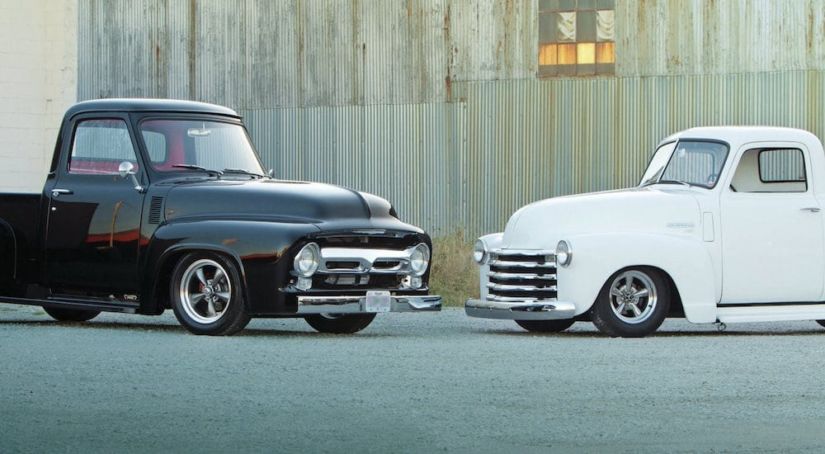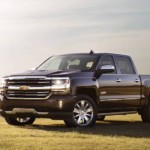Most people have heard the expression, “There are two kinds of people,” which is typically referring to personal preference, such as between brands or flavors. For example, there are people who prefer chocolate to vanilla, Android over iPhone, or Target to Wal-Mart. However, most of these rivalries are topped by the one between Ford people and Chevy people. Even drivers who are not truck enthusiasts typically have an opinion on which is better—Ford or Chevy.
“Chevys are always in the shop!” “Fords are always breaking down.” Both statements are often uttered by one party or the other. Where does this rivalry stem from? Some could argue that it’s human nature; loyalty to what they believe is the best truck brand out there. For others, one brand or the other is what they grew up with, or the one they’ve always driven. This standoff begs the question, is there a right answer? Which truck is truly better, Ford or Chevy?
To be honest, the answer to that question is going to vary from person to person. Why? Because everyone has different priorities and needs when it comes to their vehicle of choice. So, how do those rare people who stand directly on the dividing line of neutrality between Ford and Chevy make a sound decision? By breaking down the key features and figuring out which things are most important to them.
Ratings
Consumer ratings between the newest truck models for Ford and Chevy leaned heavily towards Ford in recent surveys. The Ford F-150 boasts a consumer rating of 9.3, while the Chevy Silverado rated an 8.6 out 10. Not only did consumer ratings differ, but expert ratings were also higher for the Ford F-150. The F-150’s driving dynamics, value, comfort and convenience, and overall design were all ranked higher than the Silverado by experts.
For someone who is mainly concerned with safety, this may not matter. Crash test ratings for both trucks were the same. Even their weak point, which was the overall rollover rating (4 out of 5 stars). So, while many design aspects may be a deciding factor between the F-150 and the Silverado, safety won’t be.
External Appearance
The boxy, straightforward appearance of the Chevy Silverado may appeal to some people. Others may prefer the more modern design of the F-150’s military-grade aluminum structure. While Chevy has an expansive list of options, there are not as many color options as Ford provides with the F-150. With up to 20 assorted color options, the F-150 allows truck buyers to truly customize their truck’s exterior. The Silverado packages come with fewer than ten color options.
Other external features offered by Ford include a pull-out step in back to make handling payloads less difficult, as well as pop-out steps on the sides to make entering and exiting the truck easier. These built-in steps are not offered with the Chevy Silverado, but it does have a rear-bumper step option.
Towing Capacity
A key factor in any truck is the towing capacity. Most truck owners are planning to use their trucks to haul things or pull trailers and therefore expect them to be capable of heavy lifting. While both trucks offer towing packages, Ford’s 2018 F-150 has a max towing capacity of 13,200 pounds, far exceeding the towing capacity of the Chevy Silverado, which maxes out at 12,500 pounds.
Options
While the Ford F-150 does come with many more color choices, the Chevy Silverado beats it in overall options. Many of the options provided by the Chevy Silverado are standard options, whereas the shorter list of options available with the Ford F-150 come at an extra cost. These options are where it again comes down to personal preference. Would you rather have leather or cloth seats? Bucket or split bench seats? Not only style, but color comes into play when discussing interior options, and even though Ford may outweigh Chevy with their exterior color choices, Chevy Silverado has more interior colors to choose from.
Price and Efficiency
When purchasing any car—or in this case, truck—price and efficiency are the biggest deciding factors. You may dream about the eight-foot bed with a towing package and all the bells and whistles, but your budget is going to dictate the features you can afford. The sticker price of the truck is not the only thing to consider when thinking about a budget. Other costs need to be taken into consideration where the budget is concerned. For example, insurance, gas, and maintenance and upkeep should be projected for affordability.
Something to consider when looking at pricing is the efficiency of the vehicle. Gas mileage is going to be an ongoing expense and can play a substantial role in the decision-making process. No truck has amazing gas mileage, but some are more gas efficient than others. For example, the Chevy Silverado gets an average of 20 miles per gallon while the F-150 gets around 22 miles per gallon. Though two miles per gallon is not a huge gap, it can make a significant difference over long distances.
Regarding pricing, the standard package on the Ford F-150 is more affordable than that of the Chevy, even though it comes with less of the standard options. The 2018 F-150 with standard options has a Kelly Blue Book Fair Price of $25,913, whereas the 2018 Silverado’s Fair Price is listed at $34,754. With all the add-ons and options, both trucks could reach over $60,000, so it truly depends on how much a person is looking to spend and which options most meet their needs.
While all the information provided here may help in deciding about which truck is best for you, it probably won’t settle the debate about which truck brand is better. Ultimately, which is better for you comes down to personal preference and necessity. The best advice is to figure out which features are most important to support your lifestyle and how much you can and are willing to spend. Also, be sure to research all the options. An informed decision is a smart decision.



